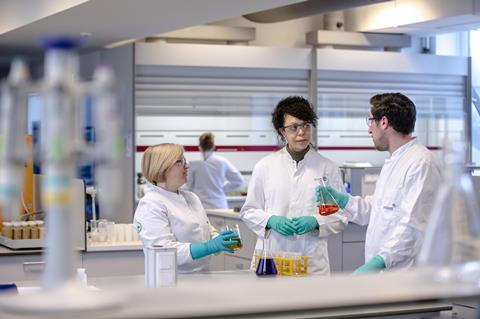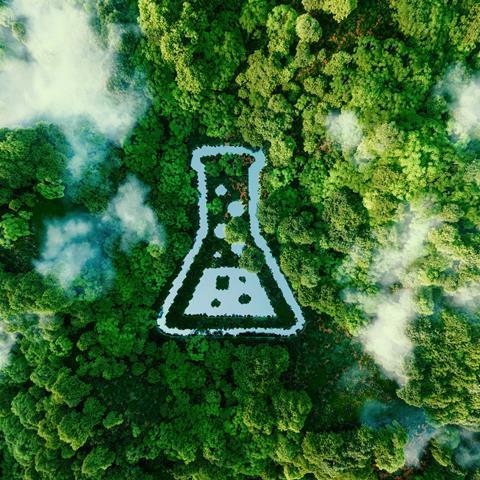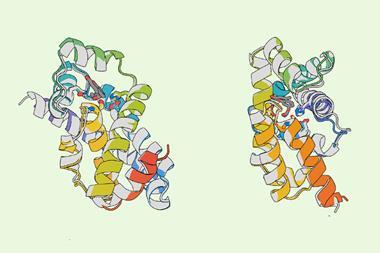It is hard to overstate the central role of chemistry and materials science in modern society. Discoveries in those fields have enabled industry to develop a broad range of services and technologies that allow us all to lead fuller, brighter and healthier lives.
However, many of the industrial processes that underpin modern society were designed in the chemical revolution of the 1950s and ’60s. A period when R&D teams weren’t as aware of the importance of contemporary green chemistry concepts such as atom economy, energy efficiency and renewable feedstocks. To ensure a more sustainable future, those processes need to be transformed with the adoption of efficiency-focused chemistry approaches. As such, the United Nations (UN) sustainable development goals (SDGs) are neither a tool nor a constraint for the industry but a scientific roadmap, inspiring the leap towards a greener and better protected planet via sustainable innovation.

A framework for better and greener business
Sustainable development is not only an environmental goal but a fundamental business goal. At Umicore, we’ve embedded the triple-line practice of balancing concerns of profit, people and planet into our strategic approach.
Hit the target
By continually setting higher standards for themselves, businesses can also ensure they remain on the cutting-edge of sustainable technology. It also helps to raise the standards of the entire industry as greener technologies become the norm.
Specific, measurable targets are key to this strategy. The goals Umicore set out in its ‘Let’s go for Zero’ strategy strive to achieve ‘zero’ in three key areas:
- Net-zero greenhouse gas emissions by 2035
- Zero inequality
- Zero harm
To avoid targets like this from being nothing more than platitudes, it’s important to establish markers, plans and measurable metrics within each of them. For example, Umicore’s net-zero roadmap includes switching to renewable electricity as fast as possible and leveraging process innovations to reduce the carbon footprint of its operations.
Maximising the positive impact of business on society also supports growing business partnerships throughout the value chain.
We employ an inclusive approach, engaging with a broad group of stakeholders that includes our employees, partners, customers, the communities we work in and the global ecosystem in which we operate. Using the UN’s SDGs as a framework, we’re able to map our community of stakeholders, technical capabilities and business goals against the global blueprint to provide a better future. Through this practice, we have identified eight core SDGs that capture Umicore’s commitment to maximising positive impact on society:

3. Good health and well-being
5. Gender equality
7. Affordable and clean energy
8. Decent work and economic growth
9. Industry, innovation, and infrastructure
11. Sustainable cities and communities
12. Responsible consumption and production
13. Climate action
By pairing this framework with our approach and technical capabilities, we believe that we can better serve both our customers and the world at large.
Catalysing change
As the world’s population continues to grow, so does the problem of waste generation. Furthermore, finite fossil-based resources are depleting at an increasing rate. These two challenges are highlighted in the 12th goal: responsible consumption and production.
As the industry looks to develop new approaches that meet these challenges, one traditional solution is providing a way forward. The concept of catalysis was introduced more than 180 years ago by Swedish chemist, Jöns Jacob Berzelius. Since then, it has become a leading tool for industrial process development due to its ability to enable efficient reactions with shorter synthetic routes. As such, the continued development of well-defined catalysts has become central to a wide variety of fields, including organic synthesis, biochemistry and materials science.
An example of the vital role catalysis plays in industry is the pioneering work by Robert Grubbs, Yves Chauvin and Richard Schrock on alkene metathesis, for which they were jointly awarded the Nobel Prize for Chemistry in 2005. In this transition metal-catalysed reaction, inactivated alkene groups can be combined to create complex carbon scaffolds, typically producing ethene as the only by-product. The ability to use alkene groups as a starting block revolutionised synthetic route development, and more importantly, provided chemists with the atom-efficient tool to leverage sustainable non-petroleum bio-based feedstocks in their processes.
SDG 12 - Responsible consumption and production
Catalyst technologies can improve the quality and efficiency of production processes across a wide range of industries, improving raw material stewardship and energy efficiency.
In 2017, the PMC division at Umicore acquired Materia’s catalyst business and rights to Grubbs’ catalyst technology from the California Institute of Technology, to expand its metathesis chemistry portfolio. These catalysts are best-in-class for performing metathesis, owing to their high activity, functional group tolerance and storage stability.
Within the pharmaceutical industry, metathesis technologies are providing synthetic chemists with simplified routes towards complex products. One example is in the synthesis of multi-functional polycyclic lactams. Here, Grubbs’ catalysts have shortened the number of steps by achieving a hindered synthesis in a high-yielding reaction.
This illustrates just one example of how a complex polycyclic lactam can be synthesised in a single high-yielding two-step process, the second of which involves a ring-closing metathesis reaction. Here, metathesis catalysts demonstrate their aptitude for achieving fundamentally difficult reactions on strained and complex reagents.
To learn more about metathesis catalysis, check out our interactive guide here.
Of these metathesis technologies, the highly selective nature of Grubbs’ and modified Grubbs−Hoveyda-type catalysts support the transformation of such alkenes with a broad variety of functional groups present. As such, metathesis offers synthesis pathways to convert bio-based substrates such as oils and fatty acids into fine chemicals and fuel components. Cheap soybean oil, for example, can be converted into valuable compounds such as α -alkenes, an important chemical that can be used as a fossil fuel replacement.
Furthermore, the high stability of these catalysts allows for incredibly high turnover numbers in the hundreds of thousands. This allows metathesis to provide significant cost advantages for high-volume, low-margin products.
Co-creating across the value chain
The ninth goal, building resilient infrastructure, emphasises the need for new approaches towards research, development and innovation to achieve the further goals by 2030. Creating advances that meet the needs of the world will only work if the entire development chain works together. This is particularly important in the relationship between academia and industry. The previous model of academia ‘pushing’ innovations to industry is no longer effective. Instead, industry and academia are working collectively to develop a mutual vision of a ‘pull’ network that includes more stakeholders. And enabling academia and industry to build trust-based relationships will promote improved learning and entrepreneurship.
Catalysis is essential to decarbonising energy, making industrial processes more efficient and reducing waste products
Knowledge sharing is a key example of how this partnership is changing. Traditionally, a focus on intellectual property (IP) in the industry has led to a culture of secrecy. However, by sharing insight into industry trends and opportunities, there is the ability to co-develop breakthrough products and processes that meet market needs. One such trend is the discovery and development of new ligand systems for catalysts. These tools can enhance catalyst activity, selectivity, sustainability and efficiency in chemical synthesis.
To illustrate the importance of ligand design, let’s look at Buchwald–Hartwig aminations. This C—N cross-coupling reaction of aryl electrophiles with amines was a breakthrough in medicinal technology and drug design. Mostly due to the universal nature of amine moieties in the industry and the importance of nitrogen atoms in modulating physicochemical properties of drugs, such as lipophilicity and pharmacokinetics.
Over the last 25 years, the development of new ligands for Buchwald–Hartwig aminations has had a huge impact on process design and development. However, despite these advantages, most of the catalysts still require higher reaction temperatures for the amination of aryl chlorides or make use of expensive ligands. Furthermore, chemical development is still challenged by small unbranched primary alkylamines such as methyl- or ethylamine for C—N coupling reactions. This is due to two inherent challenges connected with these substrates. Firstly, their small size makes it challenging to be selective between the mono- and diarylation products. Secondly, alkyl amines are prone to β-hydride elimination, which might lead to the formation of side products. Because of these limitations, comparably few synthetic protocols for the coupling of these amines have been reported in the past years.
To address these challenges, well-designed ligands are needed that allow for selective reactions. To date, phosphines are the dominant class of ligands – their electron-rich properties help to stabilise active metal species and facilitate bond activation processes, or to displace other ligands from the metal centre. Inspired by the challenges of selective aminations and the properties of phosphine ligands, Viktoria Gessner, Chair of Inorganic Chemistry at Ruhr-Bochum University, and her team developed the innovative YPhosTM ligands technology.
Why YPhos?
In a previous article, Viktoria Gessner, about YPhos ligands discussed her journey in chemistry.
Here’s a short snippet:
Could you describe your YPhos ligands and what makes them unique, compared to other phosphine ligands available?
YPhos ligands are phosphine ligands that have an ylide substituent rather than an aryl or alkyl substituent as you’d normally expect. This substituent features a carbon atom with a negative charge next to phosphorus, which makes the ligands uniquely electron rich.
Since these catalysts are more electron rich than the usual alkylphosphines available on the market, there are many catalytic applications that benefit from their use, including both palladium and gold catalysis reactions.
Frankly, if one is interested in coupling reactions, I would say you should always try the YPhos ligands. Their activity is remarkably high and can facilitate reactions under mild conditions while still giving you the best performance.
The ligand offering combines strong electron-donating properties and unique architecture to stabilise the low-coordinated palladium species via a weak intramolecular C–H∙∙∙Pd interaction. This interaction is readily cleaved to open up a free coordination site for the substrates. Even challenging substrates are converted at room temperature without the need to fine-tune the ligand specifically for a given amine or to prepare defined pre-catalysts.
Collaborating directly with Viktoria Gessner’s team, we were able to provide a market-focused viewpoint on the novel research. As such, we were able to share the evolving needs of the industry, to help facilitate the development process. Furthermore, utilising our longstanding expertise in Buchwald catalysis, we’re able to support customers and act as an interlocutor to ensure sustainable development insights are shared between the cutting-edge of academia and the pressing needs of industry.
A better future
While the challenge of a greener tomorrow is daunting, it is one that the team at Umicore Precious Metals Chemistry is readily meeting. By pairing the latest sustainable technology with our unique hands-on expertise, we’re striving to bring the entire industry toward greener, safer and better practices. The opportunities that sustainable technology brings are numerous; catalysis will be essential to the decarbonisation of energy generation, more efficient industrial processes, and fewer waste products.




















No comments yet